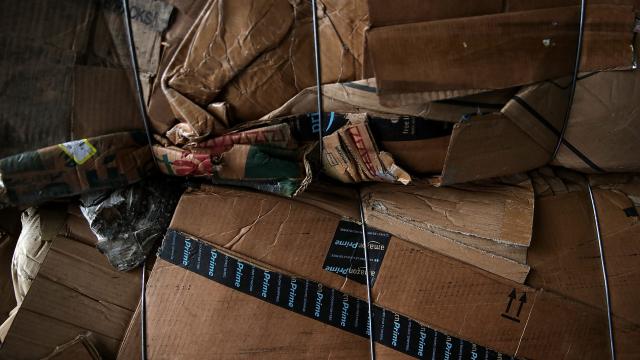Amazon has been making a mint during the pandemic. That business has resulted in multi-billion dollar pay days for the company’s soon-to-be former CEO, and millions of the company’s iconic cardboard boxes being left on doorsteps, and in lobbies and mailboxes every day. And when those piles of boxes climb higher, the cost they carry continues to climb, too.
That’s according to a new Bloomberg report detailing how the price of old corrugated cardboard — OCC in recycling industry lingo for the salvageable material that can be pulled from one of these Amazon boxes — has doubled over the past year. And that number doesn’t seem to be going down anytime soon: Another recent report from the industry trade publication Resource Recycling found that the national average price for OCC has scooted up to about $US75 ($97) dollars per ton as of last month. For reference, that price was closer to $US25 ($32) dollars per ton at this time last year.
Understanding this massive spike means understanding some basic tenets of economics: When the demand for, say, cardboard boxes spikes as rapidly as it did during the start of the covid-19 pandemic, it puts pressure on packaging manufacturers to put out more product, and fast. The thing is, that surge in demand wasn’t met with a similar surge in supply. Resource Recycling reported last year that during the initial height of the pandemic in the U.S. — around late March through April — recovered paper collection plummeted between 30% and 50%.
In other words, the production end of this supply chain now needed to do way more with way less recycled cardboard, leading to a price hike that will continue to skyrocket until recovery and recycle rates catch up with this newfound demand.
Even before the pandemic, the U.S. recycling system was an absolute mess. Until the mid-2010s, the U.S. sent most of its recycling over to China. But Chinese bans on plastic and sullied cardboard in 2018 sent recycling exports from the U.S. plummeting by more than 90% compared to the previous year. That’s led recycling programs to either divert loads of mixed paper and plastic to other Asian countries or send them to landfills and incinerators. While the box demand boom could actually help recycling programs looking to offload bales of cardboard, though Americans are going to have to figure out how to properly recycle to reduce contamination from things like diapers, used needles, and other horrors that have turned up in recycling loads.
Amazon certainly isn’t the only player contributing to the slow pileup of unrecovered boxes, but they’re arguably the biggest. In 2020, sales on the company’s platform totaled roughly $US296 ($383) billion dollars — close to a third of all e-commerce sales online for the year, and far beating out retail competitors like Target, Walmart. In other words, one out of three boxes that were delivered onto people’s doorsteps during the pandemic were Amazon-branded.
